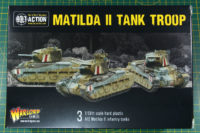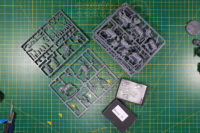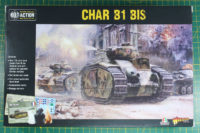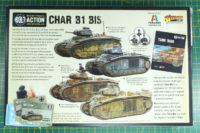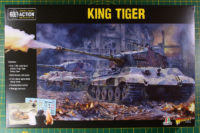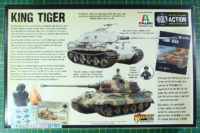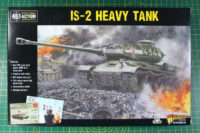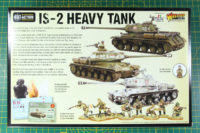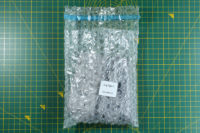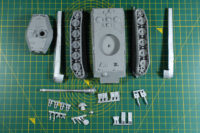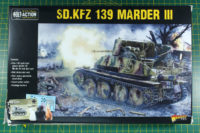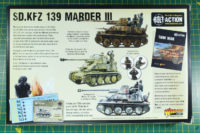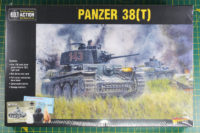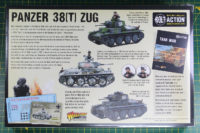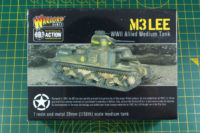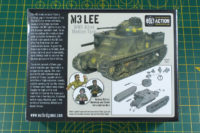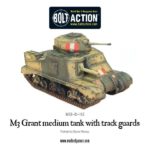Bolt Action A12 Matilda II Tank Troop
The latest plastic vehicle kit for Bolt Action is the Matilda II, shown here as the tank troop with 3 tanks. The Matilda II kit available either as a single vehicle boxed as A12 Matilda or as a three tank troop.
Of the Matilda Mk I only 140 units were build and the successor Mark II saw action in early in the war in France, but became more famous in the Desert Campaign against Italian tanks. The A12 / Mark II was produced between 1939 and August 1943, with a production run of around 3,000 units. Roughly a third of these were delivered to the Soviet Union under the Lend & Lease agreement. Captured Matilda II were used by the Germans under the nomination Infanterie Panzerkampfwagen Mk II 748 (e) or Pz.Kpfw. Mk II 748 (e). While the British replaced the "Queen of the Desert" beginning 1941 with Valentine tanks, the Australian army used their Matildas until the end of the war.
Some Perry Sprues and Bits
On the Sweetwater board (a German speaking online community with focus on historical wargaming), on irregular intervals a centralized order at the Perrys is organized.
Usually I'd suggest supporting your local dealer, but as the Perry blisters and individual sprues are more or less direct only (you can buy them at events like Crisis or Salute via Dave Thomas) this is a good way to save on shipping and even get a bit of a discount. Thanks to emigholz/Thorsten for organizing the whole bit. The last one was held before christmas, but as the Brexit (maybe) is right in front of us, we did a quick "last" one.
Bolt Action Char B1 Bis
It might be a bit odd to present a French tank during the Operation Market Garden week, but the Char B1 Bis is in there for a reason. They were used for example by the Panzerkompanie 224 in the battle of Oosterbeek.
The Char B1 was a French heavy battle tank that was designed in the 1920s and produced between 1935 and 1940. After an initial run of 34 Char B1, the pattern was improved and around 370 units of the heavier armoured and armed Char B1 Bis were build. It was one of the most powerful tanks at the time and proved to be very effective against German tanks during the Battle of France. But it was designed to be a break through vehicle and did not adapt very well to the modern, more fluid style of warfare, especially the rapid Blitzkrieg of the Germans.
Bolt Action King Tiger with Zimmerit plastic kit
The King Tiger is in a couple of variants available at Warlord Games, with the plastic kit in cooperation with Italeri being the youngest incarnation of the German heavy battle tank.
The King Tiger, or sometimes called Royal Tiger, has the internal designation of Sd.Kfz. 182 or Panzerkampfwagen VI Ausf. B Tiger II. Ausführung B and Tiger II showing it as a derivate of the Tiger I tank, but improved with sloped armour that made more use of the thick armour plates of the Tiger tanks. After initial problems with the reliability, it proved to be a remarkable battle tank towards the very last month of the war. The Tiger II was the pinnacle of the heavy tank series that actually got into production, unlike the Panzer VII Löwe or Panzer VIII Maus that never really left the drawing board (or in case of the Maus just had some mock-ups or prototypes).
Bolt Action IS-2 Heavy Tank
The heaviest plastic tank kit Warlord Games offers for the soviet forces is the IS-2 heavy tank - a perfect match for the Bolt Action campaign supplement The Road to Berlin and worthy enemy for the King Tiger. Time to honour it with a review on its own.
The IS-2 (Iosef Stalin, in Wnglisch often called JS-2 for Joseph Stalin) was the successor of the IS series heavy tank and counts as one of the most powerful tanks of World War 2. It was developed to withstand the German 8,8 cm guns and to counter Tiger and Panther tanks with the 122mm gun. It went into service in April 1944 and was used in the final offensive of the Red Army towards Berlin. Of the IS-2 were 3.850 units built between 1943 and 45, making it the most numerous tank of the IS series and triple the number of produced Tiger I. Besides being field by the Red Army / soviet forces, the IS-2 was part of the Polish and Czechoslovakian tank forces towards the end of the war. To the end of the war, the IS-3 was introduced as a derivative of the IS-2. IS-2s often would carry soviet soldiers into battle, offering valuable protection from enemy infantry. Warlord pays respect to this and adds a sprue of plastic infantry to this kit.
Bolt Action King Tiger with Henschel Turret
Another iconic tank from the late war period is the PzKpfw VI Tiger II, in this review we're looking at the resin kit by Warlord Games picturing the Ausf. B without Zimmerit and a Henschel turret.
The Tiger II, also known as King Tiger or Royal Tiger, was the derivate of the Tiger I, and combined the thick armour of the predecessor and the sloped armour of the Panther medium tank. The pattern was the pinnacle of German tank development and production, and after initial problems with reliability it proved to be a remarkable battle tank. The Tiger II first saw service in summer of 1944, at the Invasion of Normandy by the Allies, and was issued to the Wehrmacht as well as to the Waffen-SS heavy tank battalions. A total number of just below 500 units was produced until March '45, of these the first 50 were issued with the Porsche turret due to bottlenecks in production of the Henschel turret. In the first months of the productions, both variants of the Tiger (I and II) were build simultaneously.
Bolt Action Sd.Kfz. 139 Marder III
Continuing the Panzer 38(t) themed review week, with the Marder III Ausf. H tank destroyer based on the Panzer 38(t) chassis.
Based upon the chassis of the Sd.Kfz. 140 Panzer 38(t), a tank destroyer called Marder III was brought into service. The whole Marder series were makeshift tank destroyers, an interim solution, to put captured or obsolete vehicles in to use, by arming them at first with captured field guns and later with German PaK anti-tank guns. The Marder I was built upon the French Lorraine tank and the Marder II on the surplus of rapidly becoming obsolete Panzer II tanks. Marder is German for marten. The Marder III was built in three variants, as Sd.Kfz. 139, Sd.Kfz. 138 Ausf. H and Ausf. M.
Bolt Action Panzer 38(t)
Let us begin this themed week of reviews around the Panzer 38(t) with the tank itself, in this case the new plastic kit by Warlord Games.
The Panzer 38(t), registered as Sd.Kfz. 140 in Germany, was originally a pre-world war II pattern from Czechoslovakia named LT vz. 38 (Lehký tank vzor 38, Light Tank model 38). After the Third Reich took over Czechoslovakia, the tank was adopted into german service and formed the basis for many variants. Many of those variants will be covered here on the blog in the next days.
Bolt Action M3 Lee medium tank
This is a M3 review double feature, as I'll show you today the M3 Lee and the M3 Grant (with track guards). The M3 Lee kit is a regular shelf product, that comes in a boxed set. Warlord offers the Grant as a made-to-order / direct order product.
The M3 medium tank (not to be confused with the M3 Stuart / M3A1), was an American medium tank, that was supplied to other allied forces, like the British, Australian or Soviets during World War II. The differentiation between Lee and Grant, was done by the turret. The American issued turret (like in this kit) was called Lee, after the Confederate General Lee, the British issued turret after the Union General Grant.
Bolt Action M3 Grant medium tank with track guard
In addition to the M3 Lee review, this article will cover the british Grant variant of the M3 with track guards.
Unlike the M3 Lee, this kit is only available as made-to-order and therefore comes without a box in a simple bubble wrap bag.
As the M3 is already introduced in the other article, I'll focus here on the M3 Grant. Of the more than 6,000 Units the Americans build of the M3 Lee, 2,855 units were handed over to the British, who supplied them within the Commonwealth. The British had added modifications to their order, a different turret was designed with thicker armor plate, more space to house radio equipment and the machine gun cupola to be replaced with a simple hatch. The later was even done to some of the M3 Lee turrets in use by the British in China, Burma and India. And some of the M3 that were to be deployed in North Africa received sand guards, as this kit has as well.
